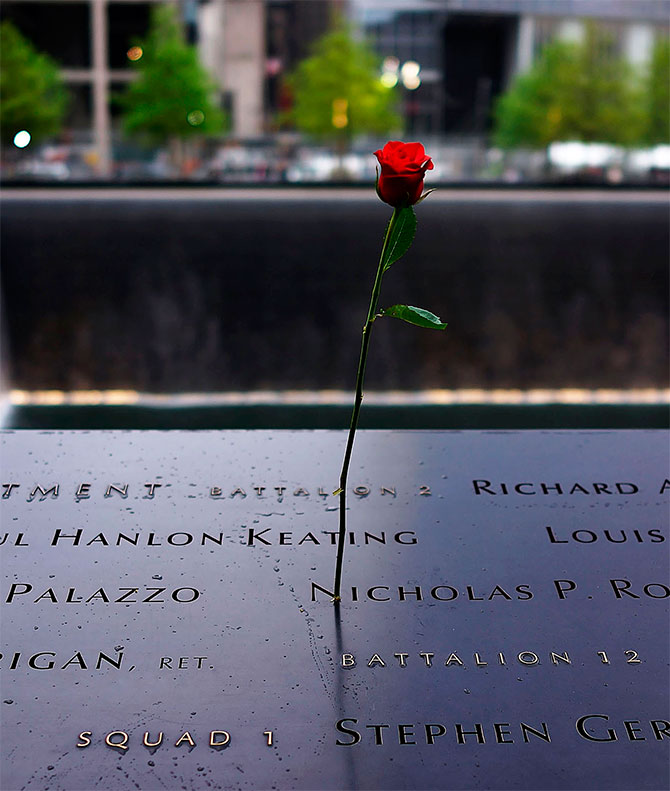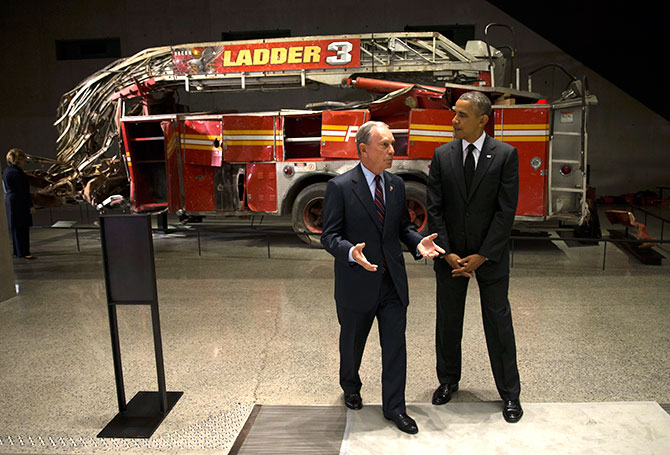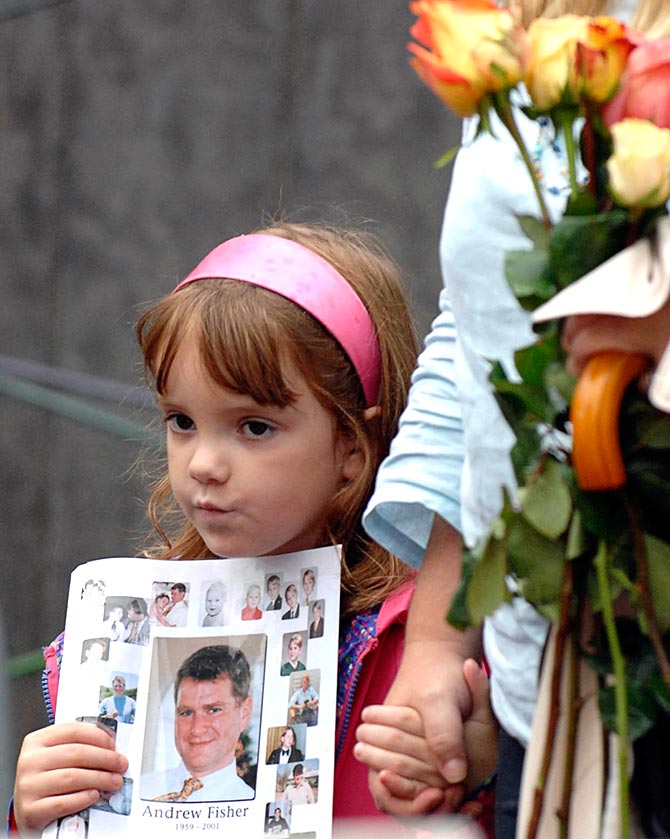
The atmosphere at the 9/11 Museum is certainly somber, but not melodramatic. The exhibition conveys a sense of peace and optimism, not frustration and despondency, says Ambassador T P Sreenivasan.
Someone had suggested that, instead of killing Osama bin Laden, the United States should have made him walk in and out of the security zone of an airport in the country for the rest of his life.
That would be worse than hell for the architect of 9/11. He could be humiliated, strip-searched, x-rayed and be in perpetual tension as to what to expect next.
That is what every US citizen and foreign visitor undergoes 13 years after the plane missiles ripped through the World Trade Centre twin towers and wounded the psyche of the United States beyond redemption.
I heard a recent quip in New York that no terrorist attack took place after 9/11 because the US authorities were constantly terrorising their own people enough.
I was looking for any sign of relaxation in security procedures during my travels in the US earlier this month. I was pleasantly surprised when I presented myself for security screening for an early morning flight from La Guardia airport to Raleigh just a day after my arrival in New York.
The agent stopped me from taking off my jacket, belt and shoes and just waved me through the security arch, with my metal rod intact in my leg. I thought for a moment that the paranoia had ended.
But things were back to normal the next day on my return journey, when I had to take everything off and also explain why I had reinforced my leg with a metal rod.
Soon after, I read about a new regulation from a tweet that in future, you should make sure that any electronic device you carry is fully charged. If you fail to turn on the device, the device itself would be confiscated and you will be subject to special procedures.
It was clear that there would be no end to the restrictions which can be imposed on citizens by a state that still lives in fear.
The height of irony is that security is at its height at the newly opened National 9/11 Memorial Museum and the areas around Ground Zero, the place where the twin towers stood. The security checks are more rigorous than those at the airports as though the terrorists are likely to strike even the museum that commemorates the tragedy they inflicted on the nation.
Kindly ...

One wished that the museum had been left open for friends and foes alike to seek a deeper understanding of what it means to be a human being living in the beginning of the 21st century. But even this museum has become a monument to the fear that has gripped the nation and visitors are constantly reminded of the perils that threaten them.
The footprints of the two towers are now vibrant pools with the names of the victims inscribed on their walls. Next to it is the giant new tower, getting ready for occupation.
The Memorial Museum, which was opened on May 21 this year near the new tower, has become a place of pilgrimage for those who were affected by the terrorist attacks in one way or another and an important stop for tourists that throng New York city throughout the year.
The mission of the museum is 'to bear solemn witness to the terrorist attacks of September 11, 2001 and February 26, 1993.' It honours nearly 3,000 victims and all who risked their lives to save others. It further recognises the thousands who survived and all who demonstrated extraordinary compassion in the aftermath of the tragedy.
The museum attests to the triumph of human dignity and affirms an unwavering commitment to the fundamental value of human life.
What strikes the visitor most is the vast area of the museum at different levels and the small number of exhibits, which have been judiciously selected and displayed. The most important exhibits are located seven storeys below the ground and the walk prepares the visitor for an awesome encounter with history.
Kindly ...

The planners obviously resisted the temptation to build a museum around the debris of the towers or to present a ghastly picture to create aversion or sympathy. Only very few significant pieces of the building are exhibited and the most memorable is the Survivors' stair, a few stone steps that survived the blast to provide some support to the fleeing survivors.
Equally impressive is the mangled communication antenna, which adorned one of the towers, showing the multitude of cables and wires, which were built with care and precision at the time of its construction.
The atmosphere is certainly somber, but not melodramatic. The exhibition conveys a sense of peace and optimism, not frustration and despondency.
Needless to say, the primary emphasis is on those who perished in the attack, but the proved heroism and sacrifice of the rescue workers receive equal attention in the museum.
In a sense, those who perished in the process of rescuing innocent victims evoke stronger feelings of admiration, which is reflected. A partially burnt fire engine is as prominently displayed as the tell tale remnants of the towers, which are embedded in the walls.
Kindly ...

A fine selection from among the very many artifacts and memorabilia created for the victims in different parts of the globe also find place in the display. A gleaming, seemingly new Honda motorcycle appears a little out of place among the exhibits, but on close examination, it turns out that it is an old prized possession of one of the victims, which was refurbished with care in accordance with the unfulfilled desire of the owner.
The pictures of the victims are tiny, but each is identified and displayed. A French photographer, who took the early pictures of the bombing from a nearby home are displayed with an account of how he stopped taking pictures and heroically began rescue work for several days.
A sense of peace and tranquility overwhelms the visitors as they walk out into the gardens outside after taking in the enormity of the tragedy and the limitlessness of human depravity.
Visitors to the museum have the facility to write their remarks on an electronic board or record their impressions on camera. The planners seem to have taken into account the instinctive desire of visitors to the monuments to become their part.
In place of the graffiti that visitors create on old monuments around the globe, the museum has the facility to record comments put signatures, which will be preserved for posterity.
Kindly ...

My thoughts as I left the museum to merge into the traffic and crowds of lower Manhattan were about a nation living in fear even years after the attack of 9/11, though it is armed with the capability of destroying the world many times over.
No one can forget where s/he was when the first plane hit the tower. I heard about it first at a meeting of the Board of Governors of the International Atomic Energy Agency in Vienna. In the midst of the severe shock that reverberated in the board room, the chairman suggested an adjournment, but the aS Ambassador took the floor to request that the meeting should continue 'as though nothing had happened.'
The meeting continued, but most delegates left the room to watch the news on the screens outside. Can the world ever move on as though nothing had happened on 9/11?
The museum elegantly captures what happened on that fateful day and the continuing impact of those events on the US and the rest of the world.
The immortal line from Virgil's Aeneid engraved on the hall reminds us: 'No day shall erase you from the memory of time.'